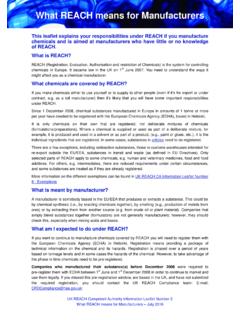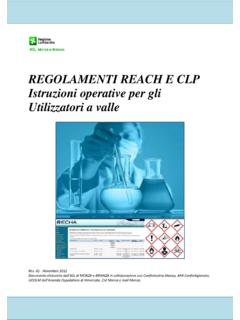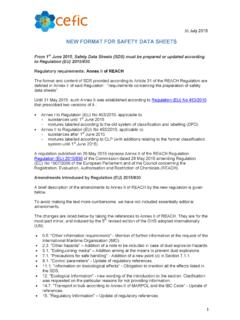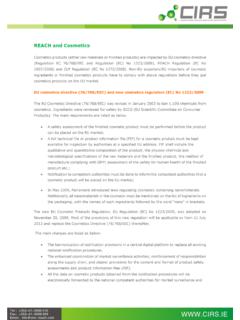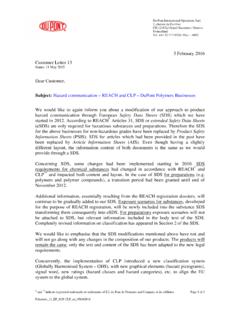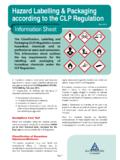Transcription of REACH and Safety Data Sheets
1 REACH and Safety data Sheets This leaflet explains the requirements for Safety data Sheets and how they will change in the future. What is REACH ? REACH (Registration, Evaluation, Authorisation and restriction of Chemicals) is the system for controlling st chemicals in Europe. It became law in the UK on the 1 June 2007. REACH adopted some of the older aspects of the chemicals system in Europe, including Safety data Sheets (SDS). Previously, under the Chemicals (Hazard Information and Packaging for Supply) Regulations 2002. (CHIP) suppliers of substances or mixtures meeting the criteria for classification as dangerous have been required to compile and supply a SDS at the first delivery of a substance or mixture. REACH took over this system and it has now been changed to take into account the new Classification, Labelling and Packaging (CLP) Regulation.
2 Do you need to provide a SDS? You need to provide a SDS if: 1. You supply a: (a) substance or a mixture (see definitions section below) that is classified as hazardous under the CLP Regulation (EC) No 1272/2008; or (b) a substance that is persistent, bioaccumulative and toxic (PBT), or very persistent and very bioaccumulative (vPvB) as defined in Annex XIII of REACH ; or (c) a substance that is included in the European Chemicals Agency's 'Candidate List' of substances of very high concern (SVHC see definitions section below) for reasons other than (a) and (b) given here. 2. You are a supplier and your customer requests a SDS for a mixture that is not classified as hazardous under the CLP Regulation (EC) No 1272/2008, but contains either: (a) a substance posing human health or environmental hazards in an individual concentration of 1 % by weight for mixtures that are solid or liquids ( , non-gaseous mixtures) or % by volume for gaseous mixtures; or (b) a substance that is carcinogenic category 2 or toxic to reproduction category 1A, 1B and 2; skin sensitiser category 1; respiratory sensitiser category 1; or has effects on or via lactation or is persistent, bioaccumulative and toxic (PBT) or very persistent and very bioaccumulative (vPvB).
3 In an individual concentration of % by weight for mixtures that are solid or liquids ( , non-gaseous mixtures); or (c) a substance on the 'Candidate List' of substances of very high concern (for reasons other than those listed above), in an individual concentration of % by weight for non-gaseous mixtures; or (d) a substance for which there are Europe-wide workplace exposure limits. If you are a supplier to EU countries other than the UK, then you may need to supply a SDS for substances or mixtures that are not classified as hazardous where they have relevant national workplace exposure limit values. 3. You are a supplier of a product listed as a special case' in paragraph of Annex 1 of the CLP. Regulation (EC) No 1272/2008 for which there are labelling derogations; , gas containers intended for propane, butane or liquefied petroleum gas.
4 Note that distributors may continue to receive mixtures that are labelled according to the Dangerous Preparations Directive 1999/45/EC; the labelling information on the SDS will usually match this. These UK REACH Competent Authority Information Leaflet Number 13 Safety data Sheets July 2016. REACH and Safety data Sheets SDS can continue to be used by distributors and downstream users according to the transitional arrangements as described in the section How does the CLP Regulation affect SDS? . You do not need to provide a SDS: 1. If the substances/mixtures are supplied in the UK and not classified as hazardous or considered PBT, vPvB or of equivalent concern ( , endocrine disruptors). 2. For certain products intended for the final user, medicinal products or cosmetics. 3. If you offer or sell dangerous substances or mixtures to the general public and you provide sufficient information to enable users to take the necessary measures as regards Safety and the protection of human health and the environment.
5 However, a downstream user or distributor can ask you to provide one. What information needs to be provided on a SDS? The Safety data sheet shall be dated and shall contain the following headings: 1. Identification of the substance/mixture and of the company/undertaking;. 2. Hazards identification;. 3. Composition/information on ingredients;. 4. First-aid measures;. 5. Fire-fighting measures;. 6. Accidental release measures;. 7. Handling and storage;. 8. Exposure controls/personal protection;. 9. Physical and chemical properties;. 10. Stability and reactivity;. 11. Toxicological information;. 12. Ecological information;. 13. Disposal considerations;. 14. Transport information;. 15. Regulatory information;. 16. Other information. Guidance on how to compile a SDS is detailed in Annex II of REACH . A SDS should be supplied in an official language of the Member State(s) where the substance or mixture is placed on the market (unless the relevant Competent Authority in the Member State(s) concerned has indicated otherwise).
6 In addition, SDS for substances or mixtures containing substances that have been fully registered under REACH will require inclusion of: . Registration numbers where appropriate (see also section on confidentiality provisions);. The identified use(s) and uses advised against in section 1;. The relevant DNELs (see definitions) and PNECs (see definitions) for that substance in section 8. UK REACH Competent Authority Information Leaflet Number 13 Safety data Sheets July 2016. REACH and Safety data Sheets Where appropriate, exposure scenarios should be included in an Annex to the SDS; or for mixtures, included in the main body , under Section 8 exposure controls/personal protection. The information in the SDS should be consistent with the information in the chemical Safety report (CSR) for that substance, or mixture if a CSA for the mixture is available.
7 Emergency Contact Number An emergency telephone number must be included in section of the SDS. This should be a number operated by competent personnel who, in the event of an emergency situation could offer clear and appropriate information in the language of the country in which the product is sold. An emergency situation could include for example, accidental ingestion or a significant spillage. In addition to the emergency contact number, suppliers of products in the UK may wish to include wording similar to: "Emergency Action: In the event of a medical enquiry involving this product, please contact your doctor or local hospital accident and emergency department.". NB. The emergency number provided on SDS for UK customers should not be that of the National Poisons Information Service (NPIS). How and when should a SDS be provided?
8 A SDS should be provided to the recipient free-of-charge, on paper or electronically, by postal delivery, fax or email. A system that merely requires customers to obtain a SDS from a company's website or from a catalogue of SDS is not considered appropriate. A SDS should be provided either before or at the time of first delivery of the substance or mixture. Where a customer re-orders substances or mixtures, then the supplier does not need to re-supply the SDS, unless the sheet's contents have changed. When should a SDS be updated? There is no statutory review period for revising a SDS; however, it needs to be updated: As soon as new hazard information or information that may affect the risk management measures becomes available; or When a substance or mixture is classified according to the CLP Regulation (see also section on how does the CLP Regulation affect SDS?)
9 '). Once an authorisation under REACH is granted or refused; or Once a restriction under REACH has been imposed. When a SDS is updated, the new dated version of the SDS, identified as Revision: date', shall be supplied to all customers (of the substance/mixture in question) from the preceding 12 months. Confidentiality provisions Some suppliers may be concerned that inclusion of the full registration number on the SDS will reveal information about their supply chains and could even allow their customers to bypass them in the supply chain. In these cases a distributor or downstream user can omit the part of the registration number referring to the individual registrant of a joint submission ( , the last four digits of the registration number). If the full registration number is not provided, then the supplier has the responsibility to provide this upon request from the enforcing authorities, or pass this request on to their supplier, within 7 days.
10 Another aspect of confidentiality relates to the provision of the full chemical identity of dangerous substances within a mixture. This can reveal the full composition of commercial formulations. To address this, one can apply to use confidential names for certain substances in dangerous preparations. Full details of how to do this and the substances within scope can be found at UK REACH Competent Authority Information Leaflet Number 13 Safety data Sheets July 2016. REACH and Safety data Sheets Enforcement If new information on hazards or risk management measures becomes available, the SDS should be updated without delay and the latest format should be used. In addition, if new information has been generated from the registration process (including the production of exposure scenarios) the SDS should again be updated without delay in the latest format.










